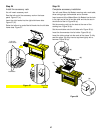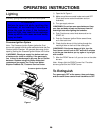
22
Step 15
Check for gas leaks
ƽ DANGER
Do not use an open flame to check for gas
leaks. Be sure there are no sparks or open
flames in the area while you check for
leaks. This will result in a fire or explosion
which can cause serious bodily injury or
death and damage to property.
Figure 25
Figure 24
Figure 23
(a)
Gas supply shut
off at the house
(c)
(d)
(e)
(b)
Check:
a) Gas supply line to manifold connection. Figure 25 (a).
b) Manifold to side burner hose connection.
Figure 25 (b).
ƽWARNING: If there is a leak at connection (a) or (b),
retighten the fitting with a wrench and recheck for
leaks with soap and water solution.
If a leak persists after retightening the fitting, turn
OFF the gas. DO NO
T OPERATE THE BARBECUE.
Contact your dealer.
c) Side burner hose to side burner connection.
Figure 25 (c).
d) Valves to manifold connections. Figure 25 (d).
ƽWARNING: If there is a leak at connections (c) or (d),
turn OFF the gas. DO NOT OPERATE THE BARBECUE.
Contact your dealer.
e) Barbecue gas supply line to natural gas supply
connection. Figure 25 (e).
ƽWARNING: If there is a leak at connection (e), turn
OFF the gas. DO NOT OPERATE THE BARBECUE.
Contact your installer.
When leak checks are complete, turn gas supply OFF
and rinse connections with water.
f) Reinstall the side burner cover. Figure 23.
ƽWARNING:You should check for gas leaks every
time you disconnect and reconnect a gas fitting.
Note - All factory made connections have been
thoroughly checked for gas leaks. The burners have been
flame tested. As a safety precaution you should recheck
all fittings for leaks before using your Weber Gas
Barbecue. Shipping and handling may have loosened or
damaged a gas fitting.
ƽWARNING: Perform these leak checks even if your
barbecue was dealer or store assembled.
You will need: soap and water solution and a rag or brush
to apply it.
Make sure side burner is OFF. Remove valve control
knob and screws. Remove porcelain top. Figure 23.
To perform leak checks: Turn ON gas supply at the
source. Figure 24.
ƽWARNING: Do not ignite burners while leak checking.
Check for leaks by wetting the connections with the soap
and water solution and watching for bubbles. If bubbles
form or if a bubble grows there is a leak.
Note - Since some leak test solutions, including soap
and water, may be slightly corrosive, all connections
should be rinsed with water after checking for leaks.


















